Adrian Collins's Blog, page 15
July 7, 2025
An Interview with David C. Smith
David C. Smith is the author or coauthor of 22 published novels, primarily in the sword-and-sorcery, horror, and suspense genres. Ten of his novels from the 1970s and 1980s are now being revised to be republished by Borgo Press/Wildside Press; the first three—which form the epic fantasy trilogy The Fall of the First World—are now available. They will be followed by Magicians and The Eyes of Night—two modern occult novels featuring the sorcerer David Trevisan—and five sword-and-sorcery novels featuring the character Oron.
In addition, Smith is the author of the screenplay Seasons of the Moon, based on his novel; has coauthored the play Coven House (with , author of the Jeff Award–winning play A Steady Rain); and coauthored the screenplay Magicians (with Joe Bonadonna, author of Mad Shadows and Three Against the Stars), based on the David Trevisan novels.
Smith is also author of the postsecondary English grammar textbook Understanding English: How Sentences Work.
Aside from writing fiction, Smith has worked as an advertising copyeditor and English teacher and for more than twenty years as a scholarly medical editor. He has served on the staff of Neurology, was the editorial production manager of the American Journal of Ophthalmology, and for more than ten years has been the managing editor of the Journal of the American Academy of Orthopaedic Surgeons.
Check out our review of Smith’s latest novel, Sometime Lofty Towers, here. As of this interview, Sometime Lofty Towers is currently crowdfunding.
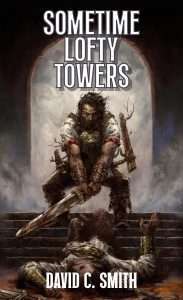 [GdM] Sometime Lofty Towers
is very much a sword & sorcery novel, what with its bloody fights and grounded characters. You’re also no stranger to the genre, having written countless stories and novels within the space. What drew you to S&S initially and what makes you come back to it again and again?
[GdM] Sometime Lofty Towers
is very much a sword & sorcery novel, what with its bloody fights and grounded characters. You’re also no stranger to the genre, having written countless stories and novels within the space. What drew you to S&S initially and what makes you come back to it again and again?
[David C. Smith] Originally, I wanted to write adventure stories, and actually put down notes for a pirate novel and then a novel about the battle of Teutoborg Forest in 9 AD. But I was restless and got bogged down in doing the required research. I loved history, though, and read quite a bit, and really liked the Conan stories, which had just come out in the Lancer editions. So I began imitating Robert E. Howard, with quite a bit of Jack London and historical fiction writers of the 1950s and 1960s thrown into the mix, and submitted them to the fanzine markets in the very early 1970s while I was in college. I’d write an S&S story, then a horror story, and switch back and forth. Gordon Linzner at Space & Time magazine, particularly, liked my stories and took many of them.
The more of these stories that I wrote—and write—the more I can see that the genre can be taken in many interesting directions, particularly, for me, in terms of characters, as well as the sense of antiquity, bringing alive elements of very deep time and mysteries about that. Atlantis, lost civilizations, archaeological discoveries—I thought when I was in junior high school that I might try to attend the University of Chicago just so I could study the ancient Sumerians and Hittites!
[GdM] Are there any lessons from your previous forays into S&S fiction that you took into Towers?
[David C. Smith] The strength of characterization. How stories are scenes, and scenes are the characters. The ideas you have that come through those characters and their situations, whether or not they create those situations. So going as far back as when I wrote Oron, my first novel, I was very aware that the characters carry everything. There’s the plot, but it doesn’t need to be mechanical. It’s driven by the characters.
In high school, I fell in love with cinema and especially silent movies, so that rhythm we get from drama has a lot to do with how I write, too. Sometimes I’ll just start typing dialogue; that can get the story going, give us insight into characters and their backgrounds. No doubt that’s why Sometime Lofty Towers opens with dialogue. You’re instantly inside the story with those people.
[GdM] What was the initial idea for Towers? What was the writing process like?
[David C. Smith] Believe it or not, the first impulse came from an old made-for-TV movie called The Over-the-Hill Gang, about a bunch of aging cowboys. That and The Wild Bunch. That quickly settled into the idea of two comrades-in-arms who fought in campaigns together before going their separate ways. It didn’t take too long to imagine the setting being one like the taking of the American frontier. The idea sat there for years until my father became very sick with asbestosis, which eventually killed him. The idea came back to me then full force, and I immediately saw him as the character Hanlin. But it took me years, off and on, to finish the story. It was emotional for me.
[GdM] Hanlin is an older character, someone who has led a very long, very violent life. He’s trying to change that, but, damn it, things keep getting in the way, and he’s got to commit violence in order to attain peace. What makes those types of characters interesting? Why did you choose that sort of narrative for Hanlin?
[David C. Smith] Characters caught up in circumstances not of their own making are always interesting, especially if those circumstances are dangerous or troubling. Then you have that person with some miles on him who has to make choices based on what he’s done and where he is now. Any one of us at any given moment is the product of choices we’ve made or did not make, and the things that have happened to us, and in an environment often not of our choosing. What parts of us are called into action when we confront the results of those choices? That’s how we find out what we’re made of.
There’s a line that comes along late in Oron—I come back to that book because I learned a lot about writing by toughing it out, writing that book—where, as strong and capable as he is, Oron realizes that the sorcerer has turned the tables on him and he admits, “I feel weak in my strength.” There’s his tragic flaw. What he’s relied on his own life has failed him. It would be frightening to confront that about oneself.
It’s not dissimilar to the situation my father found himself in. He’d fought in the Second World War, married his high school sweetheart, had the family he wanted and had settled into the career that fit him perfectly, so he’d done everything right, the way the mid-twentieth century measured it, and he still ends up being betrayed by that very system because he worked with asbestos, which the manufacturers had known since the 1920s would slowly kill you. He and the other men he knew who worked in construction, they all died from the effects of that mineral. And most of them lost most of the money they’d saved up paying either for medical care or for lawyers to fight their cases for them. There were no happy endings.
[GdM] One thing I especially enjoyed about your writing was your fight scenes. These scenes feel very surgical, very precise. The wounds inflicted during these battles aren’t superficial: they’re detailed descriptions about which muscles and tendons are damaged. What goals are you trying to accomplish when writing fight scenes like this?
[David C. Smith] That comes from my appreciation of the Iliad, and also many years spent editing orthopaedic trauma articles! I was a medical editor for decades, most of them spent with orthopaedic surgery articles. So that’s where the appreciation for detail comes from. The idea is to make the reader feel those events as deeply and realistically as they feel the other story details, the dialogue and emotions and thoughts. You know, in this type of story, these characters live rough lives, they’ve been in bloody combat and military engagements, and their weapons are edged and pointed. This is their world. It has to be presented in this way. I try to give the reader just enough of it so that, even if it’s jarring or shocking, you feel it as the protagonist does, and it explains a lot about that protagonist.
[GdM] How did you develop the kirangee? How do you go about research? They felt like a deep and well-thought out culture.
[David C. Smith] I depended on what I knew about certain American Indian cultures, both in the East and out West. Where I grew up, in Trumbull County in northeast Ohio, my friends and I could pretty easily find arrowheads and spearheads, just going out and digging. This area was the home primarily of the Iroquois and Wyandot. My dad liked the history of the Revolutionary War period. As a family, we made the trip, at least couple of times when I was young, to Fort Necessity in western Pennsylvania, in Fayette County. The battle there took place early in the French and Indian Wars. Washington lost that one to the Frech and the Huron, the Algonquin—there were a number of tribes. Anyhow, that instilled in me great respect for the indigenous peoples of this country, and I carried around a lot of the research I’d picked up over the years in regard to them, not just in the East but the Plains tribes and the Comanche and Apache.
When the story was finished, I asked a friend of mine, Michael Araujo, to read it through and give me his reaction to how I’d presented the kirangee. He’s a native of New Mexico and has a degree in Anthropology. I’d met him at Howard Days in 2019, and we hit it off. I respect his expertise. He said I did well in creating this culture.
Also, some of their culture reflects that of the early Tibetans. Much of that got lost as I worked on the story, but there’s a bit of the early Tibetan Bon religion in there. The prayer stones that are mentioned come from this influence.
In general, I have great respect for religions or beliefs that respect Nature and find it harder and harder, as I get older, to feel that way about revealed religions, at least as practiced by most people.
[GdM] We grew up in similar hometowns. Does being from the Rust Belt have any impact or influence on your writing?
[David C. Smith] A very great impact I think, yes. If nothing else, I learned to respect people who work hard because everyone in that region seems to be involved in some necessary trade or other. The practical, hands-on livelihoods. I’m not that way, so I respect people like that. But once I graduated college—Youngstown State University—there wasn’t a lot for me to do around there, as I eventually learned, although I regret not going on for my Master’s degree.
The part that hits hardest, of course, is when the mills closed in the late 1970s. One of my uncles, who worked at Sheet and Tube, had to take a job in Cleveland when that plant closed. The effects were devastating. Everyone else in my family has done all right, but the area isn’t at all what it was. There was an identity to that area, there still is, and I think it comes from people who are alert to what could happen at any minute. It was a shock to the system. But the self-awareness and the attitude of people in the Mahoning Valley—that’s definitely part of Hanlin.
Plus, there was the mob. Plenty of interesting stories there!
[GdM] What are you reading now?
[David C. Smith] Just finished lots of sword-and-sorcery short fiction for examples of style, characterization, etc., to use in my upcoming book Cold Thrones and Arcane Arts: Writing Sword-and-Sorcery Fiction. Otherwise, in nonfiction, Humanly Possible by Sarah Bakewell, a history of humanism, and rereading some old stories of M.R. James and Arthur Machen.
[GdM] What fills your time other than writing?
[David C. Smith] Our daughter, Lily, is home from her first year at college, so we have some time now to spend with her. We’re planning day trips to little towns, especially any that have bookstores! And I do have a stack of books I need to get to. More books than time to read them, as usual.
[GdM] What’s next for you? Do you have any projects that you’re working on now or are being published soon?
[David C. Smith] I’m just about finished with a book I’m calling Cold Thrones and Arcane Arts: Writing Sword-and-Sorcery Fiction. It will be coming out from Pulp Hero Press before the end of the year. It’s a review of the elements of storytelling as they’re reflected in stories from the current boom in S&S. Character, style, all of that, but I wanted to emphasize the writers working now. We know all about Howard and Wagner and Leiber. With all due respect, let’s start paying attention to the talent that’s out there today. They’re breaking new ground.
I also have to finish reviewing the pages of The Shadow of Sorcery—the proper title of that book—which Wildside will be releasing.
And my Howard biography, Robert E. Howard: A Literary Biography, is being released soon from Pulp Hero Press, in both soft cover and a hardcover edition for libraries. I revised parts of it to clear up some errors in light of recent information and to add a bit to some of the notes in the back.
Then I really want to start work on some short stories, horror stories! Plus somewhere around here I have the synopsis for a possible new Oron novel.
The post An Interview with David C. Smith appeared first on Grimdark Magazine.
July 6, 2025
REVIEW: Liminal Monster by Luke Tarzian
Liminal Monster is an emotionally charged nightmare brought to life through author Luke Tarzian’s vivid prose and seemingly unbounded imagination. Tarzian’s novella defies easy categorization, combining dark fantasy, magical realism, and Borgesian metafiction, in many ways serving as a meditation on the craft of writing and the new creations brought to life through this artistic process.
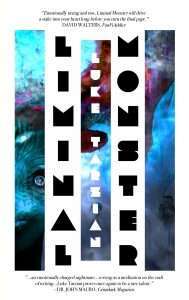 The narrative alternates between real and fantastical worlds, steadily blurring the line between the two. In our own reality, the first-person protagonist is a twenty-something-year-old author struggling with mental health issues. For some authors, writing can be an exercise in exorcising demons; for others, this process can summon demons of their own creation.
The narrative alternates between real and fantastical worlds, steadily blurring the line between the two. In our own reality, the first-person protagonist is a twenty-something-year-old author struggling with mental health issues. For some authors, writing can be an exercise in exorcising demons; for others, this process can summon demons of their own creation.
While the first-person narrative has, at least initially, a clear sense of time, the alternate fantasy world has a dreamlike quality that exists outside conventional notions of time and space. In this alternate world, the perspective shifts to a third-person protagonist known as Self. This duality in Liminal Monster recalls the parallel worlds created by Haruki Murakami in Hard-Boiled Wonderland and the End of the World and more recently in The City and its Uncertain Walls.
However, considering Murakami’s full corpus, the closest comparison to Liminal Monster would be Kafka on the Shore. Like Murakami’s opus, Tarzian’s novella explores a perversion of reality that is at times playful—a talking cat!—but more often profane. Liminal Monster has a labyrinthine feel that evokes the short stories of Jorge Luis Borges or House of Leaves by Mark Z. Danielewski, for which there is a direct allusion in the latter part of the novella.
Luke Tarzian’s writing captures the dark beauty of Edgar Allan Poe. I found myself noting a quotable passage on nearly every page of Liminal Monster. However, the tone of the novella feels more closely aligned with that of Stefan Grabiński (1887-1936), known as the “Polish Poe” or “Polish Lovecraft.” Liminal Monster specifically recalls Grabiński’s short story, “The Area,” which can be found as part of The Dark Domain anthology. “The Area” is a horrifying read in which a mentally unstable author’s creations come to life, trapping him in a psychological prison of his own making. Tarzian captures the same type of sentiment, walking the lines of parapsychology as feelings of grief during the collapse of a relationship becoming nearly tangible.
Altogether, Luke Tarzian proves once again to be a rare talent. Liminal Monster eschews conventional genre labels and narrative structure to deliver a story that soars to the greatest of literary heights while mining the deepest wells of emotion.
This review was originally published in Grimdark Magazine #43.
Read Liminal Monster by Luke TarzianThe post REVIEW: Liminal Monster by Luke Tarzian appeared first on Grimdark Magazine.
July 5, 2025
REVIEW: War Lord by Bernard Cornwell
Uhtred of Bebbanburg. Warrior. Pagan. Legend. War Lord. During his twilight years, he rests behind the castle’s mighty walls with his partner, Benedetta, his warrior companions (including the formidable Irish swordsman Finan), and his subjects. The restful and uneventful air surrounding Bebbanburg is pierced by two foreboding omens: a dragon flying south and a star falling. A struggle is coming, an altercation with consequences that will be felt for a significant time. At the centre of events will be an elderly Uhtred. Respected and feared by those on both sides of the strife and the most experienced warrior living, Uhtred knows that he has to grant his allegiance to one side and that his influence could help decide the fate of Englaland. He also knows that he wants nothing to do with the politicking or the warfare of this looming conflict. Uhtred may have affiliations and deep histories with those on both sides of the hostility, but he wants to die undisturbed behind Bebbanburg’s walls.
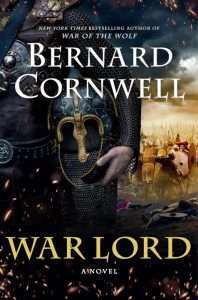 War Lord is the 13th and final entry in the popular and engaging The Saxon Stories, written by Bernard Cornwell. The novel’s first-person perspective narration, and the conflict, confrontations, and conclusion structure work nicely to build up the stakes. At this point, we have followed Uhtred’s thoughts across the 12 previous books, approximately 70 years of history. There is a sense of trust and familiarity that heightens emotional engagement, as if I am going into this showdown alongside Uhtred and his loyal companions.
War Lord is the 13th and final entry in the popular and engaging The Saxon Stories, written by Bernard Cornwell. The novel’s first-person perspective narration, and the conflict, confrontations, and conclusion structure work nicely to build up the stakes. At this point, we have followed Uhtred’s thoughts across the 12 previous books, approximately 70 years of history. There is a sense of trust and familiarity that heightens emotional engagement, as if I am going into this showdown alongside Uhtred and his loyal companions.
Throughout The Saxon Stories, Cornwell has crafted some phenomenal characters. Certain players are a joy to follow, whereas others are despicable and devious. Many of War Lord‘s sizeable cast will be familiar to readers of the series, including the warriors and fan favourites, Finan and Egil Skallagrimsson, and royalty, Æthelstan and Constantine. That being said, there are some new additions. One in particular highlights the author’s proficiency in effective characterisation. When introduced to the Irish ruler Anlaf, I quickly felt in awe of him and fearful, with his dangerous presence reverberating off the page.
Through Uhtred’s familiar and pensive narration, Cornwell skilfully reminds readers of past events and how character paths have crossed previously. For example, ‘I was furious because Æthelstan had sworn an oath that he would never invade Northumbria while I lived’ (p. 12). This is helpful as it elegantly brings me back up to speed, without spending too much page time repeating summaries of the earlier books. Interestingly, I felt that Uhtred was dwelling on the past and his accomplishments more than in prior volumes of The Saxon Stories. He is reflecting whilst being mindful of his mortality. There are poignant moments when Uhtred recounts his relationship with Alfred and that Æthelstan may complete his grandfather’s ambitions. In War Lord, Cornwell presents the ideal amount of homage and tribute, whilst remaining believable, with the events, therefore, being powerful. There are interactions in the later stages of the novel between Uhtred and a forgotten yet undeniably important character from earlier entries in the series. These felt right, rewarding, and made sense organically within this story arc.
Reviewing War Lord as a standalone story and on its own merits, I would rate it 4 stars. The dialogue is excellent, set-pieces are intelligent and convincing, and the mystical elements surrounding omens, religion and magic transport me to a well-realised 937AD. As the finale of a well-loved series and one that I have spent many hours in, War Lord gets 5 stars. It is realistic, with an almost 80-year-old Uhtred not overwhelming dozens of warriors like his younger self might have. His role, importance, and impact are undeniable whilst remaining convincing. Important characters get fitting last encounters and engagements, and the final battle sits alongside some of the finest from the series. War Lord does not change the formula that has been so successful for The Saxon Stories. It perfects, polishes and enhances it to a rewarding and memorable final outing for Uhtred and his companions. Alfred, Edward, Æthelstan, and Æthelred may live on in history yet characters such as Uhtred, Finan, Egil, Sithric, and Osferth share a place in my head. I have fought with them in shield walls across many dangerous skirmishes. Now it is time for them to rest and feast in the Valhalla of my mind.
Read War Lord by Bernard CornwellThe post REVIEW: War Lord by Bernard Cornwell appeared first on Grimdark Magazine.
July 4, 2025
REVIEW: It Was Her House First by Cherie Priest
Okay, you caught me, I admit it: haunted house stories are my guilty pleasure reads. There, I said it. They are my equivalent of a comfort read. Once in a while, I’m treated to a little bonus when an author tries something different and Cherie Priest’s upcoming title It Was Her House First falls into this latter category.
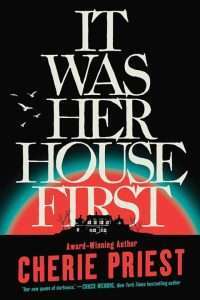 The premise with It Was Her House First is simple enough: present day Ronnie purchases a dilapidated old mansion in West Seattle at auction, sight unseen, and before even handing over the keys, the agent just has to comment on how much he hates the creepy old place that’s had multiple deaths in it and must be haunted. Prime suspect number one for haunting is the former owner, starlet of the silent cinema era, Venita Rost. Other decedents include Bartholemew Sloan, famed sleuth, and Hugh Crawford – the most recent previous owner who melted into the floor.
The premise with It Was Her House First is simple enough: present day Ronnie purchases a dilapidated old mansion in West Seattle at auction, sight unseen, and before even handing over the keys, the agent just has to comment on how much he hates the creepy old place that’s had multiple deaths in it and must be haunted. Prime suspect number one for haunting is the former owner, starlet of the silent cinema era, Venita Rost. Other decedents include Bartholemew Sloan, famed sleuth, and Hugh Crawford – the most recent previous owner who melted into the floor.
Ronnie comes equipped with prior experience and knowledge of restoration and best friend Kate, her not-quite sister-in-law. Unperturbed by the threat of spectres, Ronnie is actually hoping for some ethereal company as she wrestles with her guilt and grief following her brother’s tragic death. What she hadn’t bargained on were threats from the world of the living, intent on seizing something long left behind in the crumbling edifice.
It Was Her House First deals with themes of mental illness, the occult, grief and guilt, responsibility and regret, and ultimately acceptance. Ronnie’s story is reflected in Sloan, who holds himself responsible for the untimely death of Venita’s daughter. Venita’s story also echoes with Ronnie’s as a woman treated, by those around her, as both fragile and ‘mad’
What’s different about It Was Her House First is Ronnie’s approach to her new cohabiting situation. Instead of fighting to eradicate the ghosts, she tries to work with them, to co-exist and to restore the house together for all their sakes. I enjoy this sort of non-standard approach to the otherness around us; to share our spaces with that which is different but nevertheless present in our lives.
Priest’s writing is easy to read and compelling. Ronnie is relatable, which makes the reader want to keep turning the pages. While there is a slow build-up and exploration before the final showdown, it never feels laboursome. It Was Her House First is an enjoyable ghost story with heart and a twist that’s publishing 22nd July 2025 from Poisoned Pen Press.
Read It Was Her House First by Cherie PriestThe post REVIEW: It Was Her House First by Cherie Priest appeared first on Grimdark Magazine.
July 3, 2025
REVIEW: Old Moon Quarterly, Vol. 7
The seventh volume of Old Moon Quarterly delivers more of the high quality dark fantasy readers of the magazine have come to expect. In addition to genre titans like Michael Moorcock, Tanith Lee, and Glen Cook, the editors of Old Moon Quarterly have been outspoken about their enthusiasm for contemporary media touchstones like Berserk, Bloodborne, and the Dark Souls video games, aesthetics that visibly impact the periodical’s editorial direction. Unlike earlier issues, Old Moon Quarterly Volume 7 and 8 were crowdfunded via a Kickstarter campaign. Not only did the crowdfunding campaign allow OMQ to maintain pro rates for contributors, it allowed an extended page count and the addition of internal illustrations (including work by Morgan King of The Spine of Night fame).
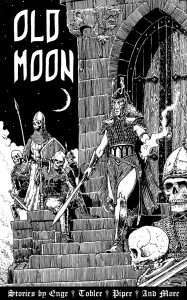 Volume 7 opens with an intriguing look at intelligent enchanted weapons, here referred to as the “speaking sword” trope. Elric of Melniboné’s malignantly manipulative blade Stormbringer is one example that readily comes to mind (and the cover artwork provided by Senkai Yami suggests an Elric homage), but the Introduction also includes a wide range of other examples from Finnish mythology to J.R.R Tolkien’s legendarium to Warhammer. The Introduction adds welcome context for the second story in the issue, “Stolen by Moonlight, Betrothed by Sun” by E. Catherine Tobler.
Volume 7 opens with an intriguing look at intelligent enchanted weapons, here referred to as the “speaking sword” trope. Elric of Melniboné’s malignantly manipulative blade Stormbringer is one example that readily comes to mind (and the cover artwork provided by Senkai Yami suggests an Elric homage), but the Introduction also includes a wide range of other examples from Finnish mythology to J.R.R Tolkien’s legendarium to Warhammer. The Introduction adds welcome context for the second story in the issue, “Stolen by Moonlight, Betrothed by Sun” by E. Catherine Tobler.
Before the speaking sword makes its appearance, however, readers are treated to a new Morlock Ambrosius tale by returning contributor and World Fantasy Award nominee James Enge. “The Ember Eyed” sees Morlock, son of Merlin, trudging down to the southernmost reaches of the world, a land of eternal fire, on a mission to obtain liquid sunlight. A nearly fatal encounter with the massive guardian spider Usli forces Morlock to reconsider his approach, however. In one of the most thrilling scenes in the story, Morlock sets to work like some sort of sorcerous MacGyver, using his ingenuity and spellcraft to equip himself for the task ahead. While it felt like Morlock was uncharacteristically relegated to the passenger seat in the finale, “The Ember Eyed” features clever storytelling and over-the-top magic. While prior experience with Morlock Ambrosius is not required to enjoy this story, the callback to the events of “Evil Honey” (published in Old Moon Quarterly Vol. 3) was delightful and welcome.
Catherine Tobler’s “Stolen by Moonlight, Betrothed by Sun” is told from the perspective of a 300-year-old sword; an estoc to be precise. Told in a non-linear fashion, the sword relates its initial encounters with its beloved owner, a formidable and rakish woman named Elisabeth Duguay-Trouin. The sword and its mistress are inevitably parted, and the estoc finds itself in the possession of a succession of different owners, some worthier than others. In contrast to the mostly doom-bringing intelligent swords mentioned in the Introduction, the one starring here was a steadfast companion, and the narrative is written in an intriguingly wistful and almost romantic fashion.
“The Torrent of Souls” by H.R. Laurence opens with the protagonist, a mercenary named Heoric, bleeding out on a tavern floor after a pointless, alcohol-fueled knife fight. The defiant recklessness with which Heoric spent his life brings him to the attention of a strangely fey woman named Aetia. In exchange for her healing ministrations, Aetia presses Heoric into service, pitting him against an avaricious sorcerer who guards the secret of immortality. One of the standout stories of this issue, “The Torrent of Souls” boasts both dreamlike imagery and gritty, violent action.
Continuing a tradition established with OMQ Volume 5, this issue also includes some poetry. Calie Voorhis’ “Footnotes on ‘Only Forever,’ The Grey Witch’s Last Poem” pairs a prose poem with extensive faux academic footnotes. This combination feels like it was designed in a laboratory to leave me cold. “In Her Waters, Raging” by Lora Gray is the other poem included in Volume 7. It’s a less tedious read than “Footnotes,” but doesn’t contribute much to the issue as a whole. While I find the OMQ editors’ fiction selections to be remarkably on point, whatever spark they’re seeing in their published poems has, thus far, eluded me.
Reminiscent of Clark Ashton Smith in terms of atmosphere if not verbiage, “The Last Gift” by Jason Mills tells the story of a group of travelers being stalked by an implacable djinn. Left destitute deep in the desert by bandits, each of the travelers shares their best quality with the others—be it words of wisdom, a treasure, or even a martial arts technique—so that if any single member makes it back to civilization they will carry something valuable from their fallen comrades. While the shape-shifting djinn proves to be a cruel and relentless threat, each of the travelers’ personal qualities prove instrumental in ultimately defeating the demon. “The Last Gift” is both clever and one of the more beautifully told stories of the issue.
Occasional Grimdark Magazine contributor Matthew John has become increasingly ubiquitous in the modern Sword & Sorcery revival, with appearances in Tales From the Magician’s Skull, The Savage Sword of Conan, and his well-received debut collection To Walk on Worlds. An appearance in Old Moon Quarterly felt almost inevitable, and John marks a strong OMQ debut with “Last Day on the Farm.” While the bulk of Volume 7’s stories include dark and unsettling elements, “Last Day on the Farm” ramps the horror up to eleven. An isolated farmer finds himself confronted with the otherworldly when a caravan crew is massacred by parasites and necromancy on his doorstep. Only Lachmannon the Kael, John’s recurring barbarian hero, can help Maric see the morning. The gory violence, grim tone, and body horror are to be expected in a Matthew John story, but he still surprised me by revealing a heretofore unseen side to Lachmannon as a character. “Last Day on the Farm” could have concluded in a variety of ways, but John chose a supremely satisfying ending.
The grimdark persists with “Bleed Me in the Water,” by Bram Stoker Award-winner Hailey Piper. For reasons that remain obscure until late in the tale, the murderess Demi takes it upon herself to lead her fellow villagers into a lethal trap within the caverns beneath her isolated island home. Along the way Demi and her victims experience a terrifying encounter with the divine. Deliciously nasty, “Bleed Me in the Water” is a story that lingers with the reader.
The hot streak continues with “Of Decadence a Child,” by David Costa. Holy warrior Beoric, He Without Sin, is sent into the vulgar world to slay a monster preying on the sinful wretches outside the Divine Church’s cloistered sanctuary. While the narrative itself is fairly straightforward, it is enhanced by the heavy, portentous atmosphere. Everything is viewed through the lens of Beoric’s religion, with the characters surrounding him instantly branded with one of the Seven Deadly Sins. Masochistic suffering is esteemed within Beoric’s faith; his armor is literally pinned to his chest, he wears boots filled with jagged pebbles, and the hilt of his sword is shrouded in spikes, “for the consequence of violence is violence itself.” Readers who enjoyed the grimdark knights of “The Feast of Saint Ottmer” (Old Moon Quarterly Volume 3) and Contra Amatores Mundi, both by OMQ editor Graham Thomas Wilcox are especially likely to appreciate “Of Decadence a Child.” It is the epitome of the “Soulsborne” fantasy Old Moon Quarterly prides itself on delivering.
“Lessons from Aulis” by Monica Joyce Evans also deals with religion, in this case Greek mythology. Back from the battlefield, Agamemnon prepares for his bath, only to be murdered by his wife Clytemnestra. The moment repeats over and over, with both Agamemnon and Clytemnestra acting and reacting slightly differently, trapped in this single moment in time. Other perspectives are incorporated, and the reader gets a sense of the greater mythic elements in play. “Lessons from Aulis” is a tad on the cryptic side, but as far as this reader is concerned it’s a more successful literary experiment than this issue’s poetry.
Finally, the issue concludes with a Graham Thomas Wilcox’s review of The Worm Ouroboros, the 1922 fantasy epic by E.R. Eddison. Much like the Old Moon Quarterly Introductions, the review meanders a bit, but it is both detailed and feels like a fair appraisal, and the writer’s enthusiasm for the novel is apparent. I would enjoy seeing Wilcox take on The Night Land (1912) by William Hope Hodgson, another early fantasy classic legendary for its archaic and challenging prose.
Old Moon Quarterly Volume 7 is another strong installment of one of the best dark fantasy fiction magazines around. With high quality stories, an extended page count, and the addition of interior artwork, the benefits of their original Kickstarter campaign are visible on the page.
At the time of this posting, Old Moon Quarterly is holding a Backerkit campaign to fund two further issues, with one of them focusing on dark Arthuriana. Returning contributors include James Enge, E. Catherine Tobler, and John Langan.
The post REVIEW: Old Moon Quarterly, Vol. 7 appeared first on Grimdark Magazine.
July 1, 2025
REVIEW: Conspiracy by A.C. Cobble
A.C. Cobble’s Conspiracy is a multi-POV epic fantasy with dragons in the skies, whispers on the wind, and daggers in the shadows. Trope-filled but razor sharp, Conspiracy is the first book in a dark, epic series that goes back to the roots of fantasy while still keeping things fresh.
“The conspirators involved in this plot are the two of you, a single dragon knight, a peasant, and a possible wizard who does not do magic?“
Conspiracy is about a country that has lost its king and has no heir. The nobles see the opportunity, as well as the country’s neighbor. Assassinations and war begin to bleed in reddened patches, and it’s up to our POV characters to get someone on the throne and staunch the blood flow, before it’s too late–before the eclipse.
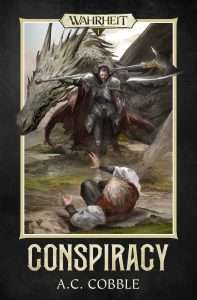 I’m going to say something that generally raises red flags: Conspiracy is a love-letter to the genre of fantasy. Normally, when I hear that, I hear “discount Tolkien,” and stay far away. No offense to anyone who reads that, but it’s not my cup of tea. A.C. Cobble, however, makes me question my stance.
I’m going to say something that generally raises red flags: Conspiracy is a love-letter to the genre of fantasy. Normally, when I hear that, I hear “discount Tolkien,” and stay far away. No offense to anyone who reads that, but it’s not my cup of tea. A.C. Cobble, however, makes me question my stance.
Conspiracy is full of classic fantasy tropes: the orphaned farm boy on a path of destiny, the duty-bound knight who disdains nobles, the greedy nobles who will do anything for power. The list goes on and on, and the book offers very few mind-bending ideas.
But something about Conspiracy just works.
A.C. Cobble has tons of talent and his writing has this factor that I can only describe as compulsively readable. At no point in Conspiracy was I bored. The dialogue, the prose, the action, the world-building, it all just comes together.
The best metaphor I have for it is that it’s like holding the family long-sword. It’s familiar, it’s comfortable, it’s been used many times, it gets the job done, and it’s sharp.
Now, while it is mostly familiar, there are a few welcome moments of character work and action that are so dark that it borders on morally black instead of morally grey. The Wizard and the Emperor especially, they offer shade and keep a dark undercurrent throughout the book. Conspiracy is hard to describe because it is classic fantasy, it is epic fantasy, and it is grimdark. I don’t know how Cobble pulled it off, but he did.
The character work is really solid throughout. We see a wide cast of characters (titled by their trope, such as “The Boy”) and it’s easy to quickly fall in love with each one. Only one of these POVs didn’t work for me, and that may strictly be because we only see him for one chapter.
My favorite character from Conspiracy is a side character who First Law fans are bound to appreciate. Cobble takes an interesting approach with this character, where he’s busy but hands-on, and he believes in a good rope and some can-do attitude. While I’m eager to read more of this character, I’d read on for the POVs I grew attached to.
Cobble’s action is great. It’s visceral and real and it offers a nice combination of magic, costs, and danger. There’s one particular action scene near the very end I’ll be thinking of for quite some time.
“People were like that, reluctant to accept truth if it came without a story. There should have been a story.”
I’ve already said this, but Conspiracy is trope-filled. That can be a positive or a negative, depending on the reader. It’s not the book that makes you go “I gotta tell everyone about this,” it’s the book you read by a fire with a dog sleeping next to you while snow falls.
If you’re looking for a true love letter to fantasy that lives up to the promise of a good story and is unerringly solid, compulsively readable, and sharpened for modern audiences, A.C. Cobble’s Conspiracy is a perfect fit.
Read Conspiracy by A.C. CobbleThe post REVIEW: Conspiracy by A.C. Cobble appeared first on Grimdark Magazine.
June 30, 2025
Grimdark Magazine Issue #43 is here!
Last Updated on July 1, 2025
In Issue Grimdark Magazine #43, we’re bringing you stories that stretch the boundaries of storytelling—brutal, bold, and absolutely soaked in the shadows of grimdark worlds. Our cover story comes from none other than Ryan Cahill, author of the Bound and Broken series. His tale, When the Skies Cried Crimson Rain, combines old gods, new myths, the paranormal, and mercenaries who might just rip your still-beating heart from your chest. Werewolves and vampires? Sure. But trust us—Ryan makes them cool again.
We’re also thrilled to feature Richard S. Ford, author of numerous fantasy trilogies, with his story The Blacksmith of Lothar’s Cross. The opening lines set the tone perfectly:
“He seemed such a gentle soul when he first came to us. A gentle giant, you might say. Peaceful, like. No one would ever have guessed his capacity for violence. But then, you can’t be peaceful unless you have that in you. That killing edge. Only violent folk who choose peace can truly be called ‘peaceful’. Those with no capacity for violence aren’t peaceful. They’re just harmless.”
If that doesn’t grab you by the throat (you’ll get what I did there in a second), just head down and check out the rest of the line up!
So kick back, pop that beer (or pour that dark roast), and dig into this issue. I had a hell of a time putting it together—and I hope you love it just as much as I do.
Cover revealAs always, Carlos Diaz has got on the front foot and driven this one straight back over the bowler’s head with a fiery representation of Ryan Cahill’s When the Skies Cried Crimson Rain.
The line upThis is an absolutely massive issue, with plenty of voices to check out in both fiction and non-fiction.
Fiction:
Bravery by Michael R. FletcherThe Blacksmith of Lothar’s Cross by R.S. FordDeath Beneath the Dread Sleeper by Lucy A. SnyderThe Name by Abhishek SenguptaWe are Vignettes by Tlotlo TsamaaseWhen the Skies Cried Crimson Rain by Ryan CahillNon-fiction:
An Interview with Martina and Hansi from NerdforgeReview: Liminal Monster by Luke TarzianOriginality and the Importance of Passion in Storytelling by Aaron S. JonesAn Interview with Jackson Dickert by Beth TablerAn interview with Editors Christopher Golden and Brian Keene and anthology contributors by Beth TablerReview: The Gryphon King by Sara OmerProject Starship: Thinner, Stronger, Smarter: The Two-Dimensional Future of Starship Design by Meghan LegerRead Grimdark Magazine #43You can also get this issue from our webstore, here.
The post Grimdark Magazine Issue #43 is here! appeared first on Grimdark Magazine.
June 28, 2025
REVIEW: 28 Years Later
Eagerly awaited by many, 28 Years Later continues the story of a rage-infected Britain that began back in 2002 with 28 Days Later, and 2007’s 28 Weeks Later. The premise, if you’ve never seen them, is a lab-designed virus that heightens aggression in those infected to levels beyond all sense and reasoning escapes into the unsuspecting population and proceeds to decimate the UK. Within a month, hardly anyone is left uninfected and those that are have to face the near-impossible task of survival against very fast, murderous, highly contagious hoards. They’re not zombies in the traditional sense as you don’t have to die to become one – a single drop of infected blood getting into your system is enough to turn you.
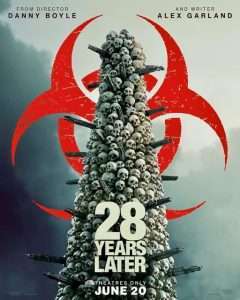 Now, in 28 Years Later, there are whole generations who have only lived in the quarantined British isles, in survival mode. Spike (Alfie Williams) is the main vehicle for this story; a 12-year old boy, raised on Lindisfarne (aka Holy Island) off the North-East coast of Northumberland. The island is only accessible at low tide via a mile-long causeway and the survivors have erected defenses to keep the infected out. Everyone trains with a bow and arrow, drilled to aim for head and heart, and there’s minimal underlying creepy-cult vibes.
Now, in 28 Years Later, there are whole generations who have only lived in the quarantined British isles, in survival mode. Spike (Alfie Williams) is the main vehicle for this story; a 12-year old boy, raised on Lindisfarne (aka Holy Island) off the North-East coast of Northumberland. The island is only accessible at low tide via a mile-long causeway and the survivors have erected defenses to keep the infected out. Everyone trains with a bow and arrow, drilled to aim for head and heart, and there’s minimal underlying creepy-cult vibes.
Feeling a bit like the opening to a classic fantasy story, 28 Years Later starts off as Spike is taken to the mainland by his dad, Jamie (Aaron Taylor-Johnson), to get his first kill in a harrowing coming-of-age practice. This first act brings in the tension of a survival horror as we see what has become of the mainland, the infected, and what it takes to stay alive. The father-son pair cross paths with an alpha, a freshly introduced type of infected for whom the virus has triggered prodigious growth and who are bigger, smarter and stronger. Through a not insignificant amount of luck, and a lot of running, Jamie and Spike make it safely back to the island where the lad is celebrated as a returning hero.
Having returned to the island village, Spike experiences that universal step in growing up where he realises his parents are fallible. The adults are hiding things. Spike’s mam, Isla (Jodie Comer), is ill, often becoming violent and confused, slipping out of time, and no one will tell Spike the truth. He resolves to take her to the mainland to find a former GP (a doctor), to help his mother, sneaking her off the island and trying to keep her safe as they trek across Northumbrian countryside. Anyone familiar with the area will spot the slightly janky geography of their quest, as they pass Sycamore Gap (RIP), the Angel of the North and still somehow come close enough to Kielder Water to meet stranded Swedish Navyman Erik (Edvin Ryding), whose entire patrol crew we see getting picked off by infected.
With the introduction of Erik, 28 Years Later shows us how the rest of the world moved on. They continued to innovate, advance and exist without the isolated Britain. Shortly after he joins Isla and Spike, we come to a scene aiming to highlight another concept of shared human experience, this time in the universality of motherhood. While I found it a bit of a clumsy attempt to communicate the message, it will stick in your mind.
By the time Spike and Isla find Dr. Kelson (Ralph Fiennes), they’ve acquired a newborn orphan. Kelson has survived for innumerable years on his own, avoiding infection by regularly covering himself in iodine, leaving his skin an interesting burnt orange colour. He has spent his years building an expansive memorial to the dead and teaches Spike of memento mori, that we all must die, but in the meantime memento amori, we all must love.
In its entirety, 28 Years Later is a story about journeys and the universality of human experience in both the literal and figurative sense. The characters journey through the landscape, as well as through time and history, and through their own hearts and minds. Director Danny Boyle and screenwriter Alex Garland have made a very British film; it is, at times, a bit weird, a bit dark, and a bit depressing. There’s an intrinsic linking of people to place, to the land around us, that blends well with the folkish imagery throughout. It’s also a deeply reflective film that can’t be removed from the tumultuous politics that colour it, perhaps even more so than the 2002 original.
As we are moved into more isolationist groups, by choice or by force, by the mindless rage zombies around us, 28 Years Later is here to show us that we can survive. Alone or in our communities. When it comes down to it, our shared humanity and experience is how we resist that which would tear us apart.
The post REVIEW: 28 Years Later appeared first on Grimdark Magazine.
June 26, 2025
REVIEW: Sometime Lofty Towers by David C. Smith
Sometime Lofty Towers by David C. Smith is a grimdark, sword and sorcery novel that asks a simple question: what is the best way to live a life? Deep underneath a narrative of revenge and forgiveness, blood and changing futures lies a story that is as philosophical as its protagonist. No stranger to sword and sorcery stories himself, David C. Smith, author of Tales of Attluma and many Red Sonja novels, crafts a tale that follows Hanlin, a veteran warrior seeking to end his violent past and live a peaceful life.
 Hanlin, a Logen Ninefingers-type if Logen went to therapy and attended a few philosophy classes, finds that he cannot quite leave that dark past behind yet, as a former adversary he once thought dead is rumored to be very much alive. Joining with the kirangee, an indigenous tribe threatened by the ruthless colonialist Lady Sil, Hanlin must learn how to live in a world much different from the way he’s always lived. I loved the predicaments that Hanlin has faced: as a man looking to change his very nature, he’s torn between doing things the old way, or changing them to fit a different narrative. He does not make these choices easily, and friends and newfound allies suffer the consequences when things get bad. You truly feel the weight of Hanlin’s choices as he helps this tribe, not as a conquering hero, but as someone looking to be part of a whole, not the center.
Hanlin, a Logen Ninefingers-type if Logen went to therapy and attended a few philosophy classes, finds that he cannot quite leave that dark past behind yet, as a former adversary he once thought dead is rumored to be very much alive. Joining with the kirangee, an indigenous tribe threatened by the ruthless colonialist Lady Sil, Hanlin must learn how to live in a world much different from the way he’s always lived. I loved the predicaments that Hanlin has faced: as a man looking to change his very nature, he’s torn between doing things the old way, or changing them to fit a different narrative. He does not make these choices easily, and friends and newfound allies suffer the consequences when things get bad. You truly feel the weight of Hanlin’s choices as he helps this tribe, not as a conquering hero, but as someone looking to be part of a whole, not the center.
Smith’s writing in Sometime Lofty Towers is economical, precise, and tactile. Every sword swing, every ounce of blood spilt feels like it’s happening in front of you. The battles in this novel feel grounded and gritty, but it doesn’t trivialize or fetishize the violence. Whereas a character like Conan the Barbarian might relish in victorious battle, Hanlin knows that, unfortunately, he’s very good at swinging a sword and doesn’t valorize combat as much as he knows it’s a tool used to do the right thing in a world full of violence.
Sometime Lofty Towers’ stoic protagonist fits right at home with its economical world building. You get just enough of the world around Hanlin that lets you fully imagine it without it bogging the story down in too many details. I certainly appreciated the balance.
Sometime Lofty Towers is a fantasy novel without all the cruft. It’s a tight, fast book that appreciates your time, and gives you a story with a fascinating, proactive protagonist on a journey of self-reflection as he navigates the meditates on what the right thing to do is. I loved every word in this book. It speaks to those who have ever tried to reinvent themselves in a world that only wants you to be one thing. You’ll definitely want to pick this one up.
As of this review, Sometime Lofty Towers is currently crowdfunding.
The post REVIEW: Sometime Lofty Towers by David C. Smith appeared first on Grimdark Magazine.
June 24, 2025
The best dark fantasy and science fiction books of 2025 so far
The first half of 2025 has much to offer fans of dark and grimdark fantasy and science fiction. From dark flintlock fantasy horror to dysfunctional backstabbing families, a band of misfit anti-heroes to all-out war in an infinitely large library, there is something on our list for just about everybody. We are very fortunate to have been provided with heaps of amazing review opportunities so far this year, and from those we have compiled our team’s choices for the best of dark and grimdark SFF so far in 2025.
Grave Empire by Richard Swan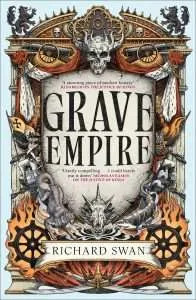 Author Richard Swan takes us back into the Empire of the Wolf with Grave Empire, the dark flintlock fantasy horror with sweeping epicness, an intense and building sense of dread, and characters grimdark fans are going to really enjoy. Fans of The Justice of Kings, The Tyranny of Faith, and The Trials of Empire are in for an absolute treat, and new readers can pick this up without having read the previous trilogy.
Author Richard Swan takes us back into the Empire of the Wolf with Grave Empire, the dark flintlock fantasy horror with sweeping epicness, an intense and building sense of dread, and characters grimdark fans are going to really enjoy. Fans of The Justice of Kings, The Tyranny of Faith, and The Trials of Empire are in for an absolute treat, and new readers can pick this up without having read the previous trilogy.
Read the rest of our review here.
About the BookFrom critically acclaimed author Richard Swan, Grave Empire begins the epic tale of an empire on the verge of industrial revolution, where sorcery and arcane practices are outlawed – and where an ancient prophecy threatens the coming end of days.
Blood once turned the wheels of empire. Now it is money.
A new age of exploration and innovation has dawned, and the Empire of the Wolf stands to take its place as the foremost power in the known world. Glory and riches await.
But dark days are coming. A mysterious plague has broken out in the pagan kingdoms to the north, while in the south, the Empire’s proxy war in the lands of the wolfmen is weeks away from total collapse.
Worse still is the message brought to the Empress by two heretic monks, who claim to have lost contact with the spirits of the afterlife. The monks believe this is the start of an ancient prophecy heralding the end of days—the Great Silence.
It falls to Renata Rainer, a low-ranking ambassador to an enigmatic and vicious race of mermen, to seek answers from those who still practice the arcane arts. But with the road south beset by war and the Empire on the brink of supernatural catastrophe, soon there may not be a world left to save…
Read Grave Empire by Richard Swan, Recommended by AdrianThe Diplomacy of the Knife by C.M. Caplan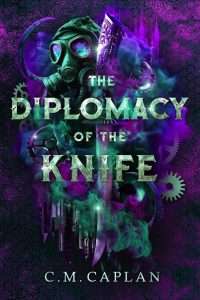 We don’t know what type of dark alchemy happened in C.M. Caplan’s mind while writing The Diplomacy of the Knife, but this second instalment in the Four of Mercies series is absolutely batshit crazy in the best way possible. It’s bigger, better, darker, filthier, more complex, more gut wrenching, more deliciously deranged, and it just bleeds with a manic ‘WHAT THE FUCK?’ energy that is honestly unparalleled. In other words, this is how you write one hell of a satisfying sequel! If you are ready for an exceptionally inventive, diverse and genre-blendy feat of storytelling madness that will excite, delight, and freak you the fuck out with each new turn of the page, then we simply can’t recommend the Four of Mercies series highly enough.
We don’t know what type of dark alchemy happened in C.M. Caplan’s mind while writing The Diplomacy of the Knife, but this second instalment in the Four of Mercies series is absolutely batshit crazy in the best way possible. It’s bigger, better, darker, filthier, more complex, more gut wrenching, more deliciously deranged, and it just bleeds with a manic ‘WHAT THE FUCK?’ energy that is honestly unparalleled. In other words, this is how you write one hell of a satisfying sequel! If you are ready for an exceptionally inventive, diverse and genre-blendy feat of storytelling madness that will excite, delight, and freak you the fuck out with each new turn of the page, then we simply can’t recommend the Four of Mercies series highly enough.
Read the rest of our review here.
About the BookPetre Mercy’s had a rough time since he rode home on a cyborg horse. He’s lost a hand that’s been replaced with a mess of steel and piano string, broke his thyroid-powered sword, and helped ignite a civil war that’s engulfed the countryside.
His sister, The Queen, has ordered him to root out any traitors in Mercy House. But Petre can hardly ferret out the truth from his siblings, let alone a vast network of spies with counterplots. And every day more turncoats move against him.
If he has any hope of putting down this uprising, he’ll have to work with a sister he’s still learning to trust. But his enemies are one step ahead of him at all times. And they’re hiding in the last place he’d think to look.
Read The Diplomacy of the Knife by C.M. Caplan, Recommended by EsmayAn Inkling of Flame by Z.B. Steele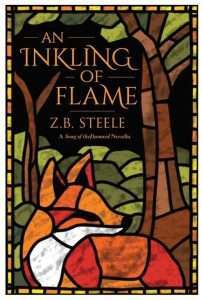 Z.B. Steele’s An Inkling of Flame is a wonderfully crafted novella, a masterclass in short-form storytelling.
Z.B. Steele’s An Inkling of Flame is a wonderfully crafted novella, a masterclass in short-form storytelling.
It introduces a captivating cast of characters—a found family forged in the years leading up to a war—and a brand new world brimming with conflict. The characters quickly grow on you, their banter and loyalty gradually giving way to a thoughtful exploration of the horrors of war and the enduring strength of the bonds that sustain us through adversity.
Fun, clever and witty, An Inkling of Flame is a fantastic introduction to the world of Song of the Damned, which I plan to dive deeper into as soon as possible!
Read the rest of our review here.
About the BookTell me how it happened…
Layne was a soldier, conscripted to fight under the Fox in a vengeance fueled march. He, and his friends, were due for a fated confrontation, one that has ended in blood and loss. Now, the inquisitors want to hear every detail of his conscription, his training, and the duel against the assassin in grey.
Read An Inkling of Flame by Z.B. Steele, Recommended by ArinaBury Our Bones in the Midnight Soil by V.E. SchwabBury Our Bones in the Midnight Soil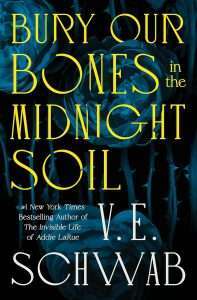 is a modern gothic novel with some light horror. Schwab masterfully handles themes of loss, love, loneliness, and many others in a delicate way. Schwab’s characters are the most central part of this story, rather than it being an action-packed plot, and stepping into the world was so easy.
is a modern gothic novel with some light horror. Schwab masterfully handles themes of loss, love, loneliness, and many others in a delicate way. Schwab’s characters are the most central part of this story, rather than it being an action-packed plot, and stepping into the world was so easy.
This is the sort of book that will speak to people’s souls. It might not have epic battles, political manoeuvring, or a quest to save the world, but it will make people feel seen. Readers will see little pieces that are like them, dotted across the three narratives. It feels like Schwab has put their everything into Bury Our Bones in the Midnight Soil, and reading it was an excellent experience.
Read the rest of our review here.
About the BookThis is a story about hunger.
1532. Santo Domingo de la Calzada.
A young girl grows up wild and wily―her beauty is only outmatched by her dreams of escape. But María knows she can only ever be a prize, or a pawn, in the games played by men. When an alluring stranger offers an alternate path, María makes a desperate choice. She vows to have no regrets.
This is a story about love.
1827. London.
A young woman lives an idyllic but cloistered life on her family’s estate, until a moment of forbidden intimacy sees her shipped off to London. Charlotte’s tender heart and seemingly impossible wishes are swept away by an invitation from a beautiful widow―but the price of freedom is higher than she could have imagined.
This is a story about rage.
2019. Boston.
College was supposed to be her chance to be someone new. That’s why Alice moved halfway across the world, leaving her old life behind. But after an out-of-character one-night stand leaves her questioning her past, her present, and her future, Alice throws herself into the hunt for answers . . . and revenge.
This is a story about life―
how it ends, and how it starts.
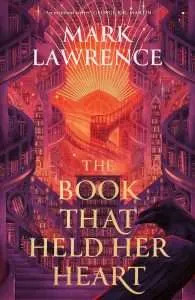 The feeling of emotional devastation lingers long after closing the back cover of Mark Lawrence’s The Book That Held Her Heart, the final volume of his mind-bending Library Trilogy, which began with the highly acclaimed The Book That Wouldn’t Burn and continued with its sequel, The Book That Broke the World. Mark Lawrence writes with wit and gusto, leading to an ending that hits so hard that I feel like the publisher should include a packet of tissues between the last page and back cover.
The feeling of emotional devastation lingers long after closing the back cover of Mark Lawrence’s The Book That Held Her Heart, the final volume of his mind-bending Library Trilogy, which began with the highly acclaimed The Book That Wouldn’t Burn and continued with its sequel, The Book That Broke the World. Mark Lawrence writes with wit and gusto, leading to an ending that hits so hard that I feel like the publisher should include a packet of tissues between the last page and back cover.
The Book That Held Her Heart is the perfect conclusion to Mark Lawrence’s most ambitious trilogy to date. Altogether, the Library Trilogy is one of the most profound and wholly original works of fiction that I’ve read in the past two decades. The Library Trilogy should place Mark Lawrence’s name in the same breath as other twenty-first century masters of speculative fiction.
Read the rest of our review here.
About the BookTwo people once connected by a vast and mysterious library are now separated and must overcome time and distance to reunite and bring peace to their worlds, in the final book of the Library Trilogy.
The fate of an infinite library hangs on one book, a book that holds the power to break the unbreakable. In the face of such forces, fragile things like hearts, worlds, and even family seem certain to fail.
The people most vital to Livira are scattered across time and space—lost, divided into factions, in mortal peril. Somehow she must bring them together and resolve the unresolvable argument that fuels the library’s war.
The bond between Livira and Evar has stretched and stretched again. Can it hold at the end, when things fall apart? Can it unite them against impossible odds?
This is the last chapter, the final page. The end threatens and no one—not characters, readers, or even the author—will emerge unscathed.
Read The Book That Held Her Heart by Mark Lawrence, Recommended by JohnThe Whisper that Replaced God II: Silent Almighty by Timothy Wolff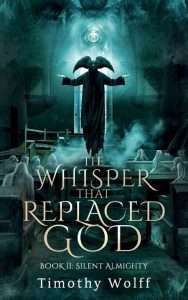 The Whisper that Replaced God II: Silent Almighty is Timothy Wolff’s follow up to his certifiably insane, sardonic, beautiful, bloody novella The Whisper that Replaced God. Reeling from the ending of book one, Lord Mute, now bathed in power, prestige, and gold, finds everything in life rather boring … until a challenger appears. Wolff ramps up the irony, prose, and bloodshed from book one and punches his ticket as a must-buy author.
The Whisper that Replaced God II: Silent Almighty is Timothy Wolff’s follow up to his certifiably insane, sardonic, beautiful, bloody novella The Whisper that Replaced God. Reeling from the ending of book one, Lord Mute, now bathed in power, prestige, and gold, finds everything in life rather boring … until a challenger appears. Wolff ramps up the irony, prose, and bloodshed from book one and punches his ticket as a must-buy author.
Read the rest of our review here.
About the BookRuling as king does not suit a man like Mute. The boredom. The monotony. The permanent stagnation…
Until he arrived. The one with the Gift of Silence. The one wielding a dagger. The one who would mold Balewind into a temple to the Silent Almighty. Lord Deaf intends to be the scream that replaced a whisper, offering one final message to the realm before it never hears again:
Bestow upon me your pain, your illness, your sorrow. Silence will absolve them all.
Read The Whisper that Replaced God II: Silent Almighty by Timothy Wolff, Recommended by Z.B.Mists of Memory by N.C. Scrimgeour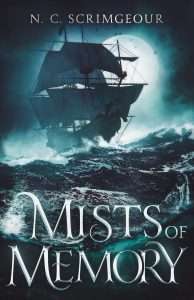 How do you follow up one of the best debut dark fantasies of recent times? By making lightning strike twice – screw that, by making it strike harder. N.C. Scrimgeour’s follow up to the flintlock folklore Scots-inspired fantasy revelation that was Sea of Souls gives us everything I loved about the original – powerful prose; dark, fog-drenched atmosphere; sublime, subtle, vibrant characterization; and pin-point worldbuilding – but twists the knife, sometimes literally, and ratchets up the drama and emotion. Mists of Memory is a non-stop, deliciously dark white-knuckle ride across waters perilous that somehow finds time to stop and give us character moments that make you and break you, sometimes on the same page. One of the must-read fantasies of the year.
How do you follow up one of the best debut dark fantasies of recent times? By making lightning strike twice – screw that, by making it strike harder. N.C. Scrimgeour’s follow up to the flintlock folklore Scots-inspired fantasy revelation that was Sea of Souls gives us everything I loved about the original – powerful prose; dark, fog-drenched atmosphere; sublime, subtle, vibrant characterization; and pin-point worldbuilding – but twists the knife, sometimes literally, and ratchets up the drama and emotion. Mists of Memory is a non-stop, deliciously dark white-knuckle ride across waters perilous that somehow finds time to stop and give us character moments that make you and break you, sometimes on the same page. One of the must-read fantasies of the year.
Read the rest of our review here.
About the BookShe had no need for the tides to be kind, not if she became the storm…
The Selkie Isles were meant to be a safe haven for Isla Blackwood, a place she could finally call home. Instead, she finds herself hunted across the sea for a pelt the Grand Admiral will do anything to recover.
But the Admiralty isn’t the only threat on the horizon. A terrible mist sickness plagues the isles, carried by the vengeful spirits of fallen selkies. To stop it, Isla will need to learn the lost secrets of her mother’s rare magic—if she can earn the trust of those who call her an outsider.
Back in the capital, Darce Galbraith prepares to set sail with the enemy fleet. Surrounded by danger, he will do all he can to sabotage their search—even if it means risking the wrath of the Grand Admiral himself.
A storm is ready to break on human and selkie alike, and only the tides know what’s waiting on the other side…
Mists of Memory is the gripping sequel to Sea of Souls, a dark fantasy saga steeped in Scottish folklore, ancient magic, and monsters that feel all too familiar. Perfect for fans of Rachel Gillig and Ava Reid.
Read Mists of Memory by N.C. Scrimgeour, Recommended by EdThe Devils by Joe Abercrombie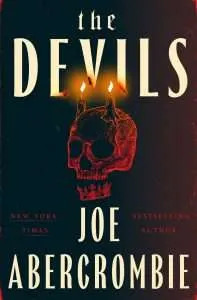 I absolutely loved The Devils by Joe Abercrombie. As a bit of a departure from Joe’s usual fare of political and complex character work, this was a plot-heavy, fast-paced rollicking good ride that made me laugh out loud several times and had several action segments that left me breathless. I hope everyone else enjoys their monster mash tour around Joe’s absolutely bonkers version of an alternative medieval Europe as much as I did!
I absolutely loved The Devils by Joe Abercrombie. As a bit of a departure from Joe’s usual fare of political and complex character work, this was a plot-heavy, fast-paced rollicking good ride that made me laugh out loud several times and had several action segments that left me breathless. I hope everyone else enjoys their monster mash tour around Joe’s absolutely bonkers version of an alternative medieval Europe as much as I did!
Read the rest of our review here.
About the BookA brand-new epic fantasy from New York Times bestselling author Joe Abercrombie, featuring a notorious band of anti-heroes on a delightfully bloody and raucous journey
Holy work sometimes requires unholy deeds.
Brother Diaz has been summoned to the Sacred City, where he is certain a commendation and grand holy assignment awaits him. But his new flock is made up of unrepentant murderers, practitioners of ghastly magic, and outright monsters. The mission he is tasked with will require bloody measures from them all in order to achieve its righteous ends.
Elves lurk at our borders and hunger for our flesh, while greedy princes care for nothing but their own ambitions and comfort. With a hellish journey before him, it’s a good thing Brother Diaz has the devils on his side.
Read The Devils by Joe Abercrombie, Recommended by SallyOne Yellow Eye by Leigh Radford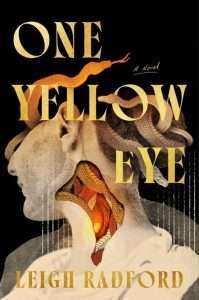 One Yellow Eye by Leigh Radford, coming this July, is a heartbreaking, confronting, deeply internal story about love, loss, and grief—with a zombie apocalypse setting just to keep things interesting! Radford brings a fresh twist to the zombie genre by having the virus stopped in its tracks and contained, but not before death and destruction turn London into a ghost town. Kesta’s husband has been infected, but she keeps him alive and restrained in their flat while she scrambles to find a cure for the very disease that has taken him from her. Her struggle with the science of the virus is skillfully explained, and the liminal kind of half-grief of living with her undead husband is entirely too approachable for anyone grappling with complicated loss. I cannot wait for One Yellow Eye to drop this summer so I can finally talk about it with fellow readers!
One Yellow Eye by Leigh Radford, coming this July, is a heartbreaking, confronting, deeply internal story about love, loss, and grief—with a zombie apocalypse setting just to keep things interesting! Radford brings a fresh twist to the zombie genre by having the virus stopped in its tracks and contained, but not before death and destruction turn London into a ghost town. Kesta’s husband has been infected, but she keeps him alive and restrained in their flat while she scrambles to find a cure for the very disease that has taken him from her. Her struggle with the science of the virus is skillfully explained, and the liminal kind of half-grief of living with her undead husband is entirely too approachable for anyone grappling with complicated loss. I cannot wait for One Yellow Eye to drop this summer so I can finally talk about it with fellow readers!
In this heart-wrenching and unique spin on the zombie mythos, a brilliant scientist desperately searches for a cure after a devastating epidemic while also hiding a monumental secret—her undead husband.
How far would you go to save your marriage? For British scientist Kesta Shelley, there is no limit.
Having always preferred the company of microbes, Kesta has spent her life looking down the barrel of a microscope rather than cultivating personal relationships. But that changed when Kesta met Tim—her cheerleader, her best friend, her absolute everything. So, when he was one of the last people in London to be infected with a perplexing virus that left the city ravaged, Kesta went into triage mode.
Though the government has rounded up and disposed of all the infected, Kesta is able to keep her husband (un)alive—and hidden—with resources from the hospital where she works. She spends her days reviewing biopsy slides and her evenings caring for him, but he’s clearly declining. The sedatives aren’t working like they used to, and his violent outbursts are becoming more frequent. As Kesta races against the clock, her colleagues start noticing changes in her behavior and appearance. She is withering away, self-medicating with alcohol, and has stopped attending her mandated ZARG (Zombie Apocalypse Recovery Group) meetings. Her care for Tim has spiraled into absolute obsession.
There are whispers of a top-secret lab working on a cure, and Kesta clings to the possibility of being recruited like a lifeline. But can she save her husband before he is discovered? Or worse…will they trigger another outbreak?
Read One Yellow Eye by Leigh Radford, Recommended by KrystleOf Empires and Dust by Ryan Cahill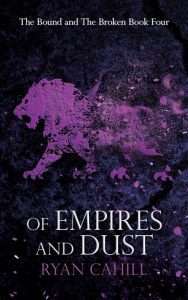 My pick is Of Empires and Dust, the fourth novel in The Bound and The Broken series, by Ryan Cahill that released at the end of March. This is officially the longest book I’ve ever read, but don’t be intimidated by the page count as Cahill’s effortless prose flows so smoothly you’ll be sailing through it, caught on a wave of astonishment at how he’s managed to keep all these threads, weaving intricate patterns into this epic tale, straight in his head. The growth of story, characters and author that this series is demonstrating is a wonder.
My pick is Of Empires and Dust, the fourth novel in The Bound and The Broken series, by Ryan Cahill that released at the end of March. This is officially the longest book I’ve ever read, but don’t be intimidated by the page count as Cahill’s effortless prose flows so smoothly you’ll be sailing through it, caught on a wave of astonishment at how he’s managed to keep all these threads, weaving intricate patterns into this epic tale, straight in his head. The growth of story, characters and author that this series is demonstrating is a wonder.
Expect more betrayals, lies, loss and revenge in this penultimate installment to the (main) series, alongside some beautifully executed musings on identity, community and belonging. This is a dark, epic masterpiece that feels like a welcome embrace against a bitter-cold and stormy night in the unrelenting wilderness. Truly, chef’s kiss.
About the BookI’ldryr viel asatar. I sanvîr viel baralun.
In fire we are forged. In blood we are tempered.
In the Aravell woodland, Calen Bryer grapples with the fallout from the Battle of Aravell. The path forward is littered with choices that will bleed him dry. But he is a Draleid, he is a guardian, and he will always stand when others call. He will be the light they look to.
His sister, Ella, lies fragmented, her mind split between worlds, her fate unknown. But the blood of the wolf is strong.
Hundreds of miles away, in the western villages of Illyanara, Dahlen Virandr leads the defense of Salme and all its inhabitants gathered from across the region. The Uraks are unrelenting, and they know only blood and death. If this is to be his end, he will enter Achyron’s Halls as a warrior who would not yield.
Below the mountains of Lodhar, Queen Kira waits in the dark while Hoffnar attempts to seize control of the Freehold and lead the dwarves towards a new dawn of war.
In Valtara, Dayne Ateres hunts those who betrayed his family, while Alina prepares her army to besiege the legendary Achyron’s Keep.
At the edges of the Burnt Lands, Rist Havel is offered a new path forward, one that few have ever trodden, one that could forge him into a mage of no equal.
With the news that Ilkya and Jormun have fallen, along with their soulkin, Eltoar finds himself face-to-face with Salara Ithan – a remnant of his past life that he had long thought dead.
As the Blood Moon taints the sky, Kallinvar and the Knights of Achyron battle tirelessly against the Shadow, doing everything within their power to hold back the darkness.
Read Of Empires and Dust by Ryan Cahill, Recommended by RaiNeed more book recommendations?We’ve been looking at the best in dark and grimdark SFF for years; here are the last few years posts to help you make sure that TBR will start teetering over you!
Best grimdark and dark SFF books of 2024Best grimdark and dark SFF books of 2023Best grimdark and dark SFF books of 2022Best grimdark and dark SFF books of 2021Best grimdark and dark SFF books of 2020Best grimdark and dark SFF books of 2019The post The best dark fantasy and science fiction books of 2025 so far appeared first on Grimdark Magazine.


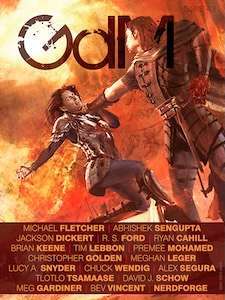 Read on Amazon
Read on Amazon

